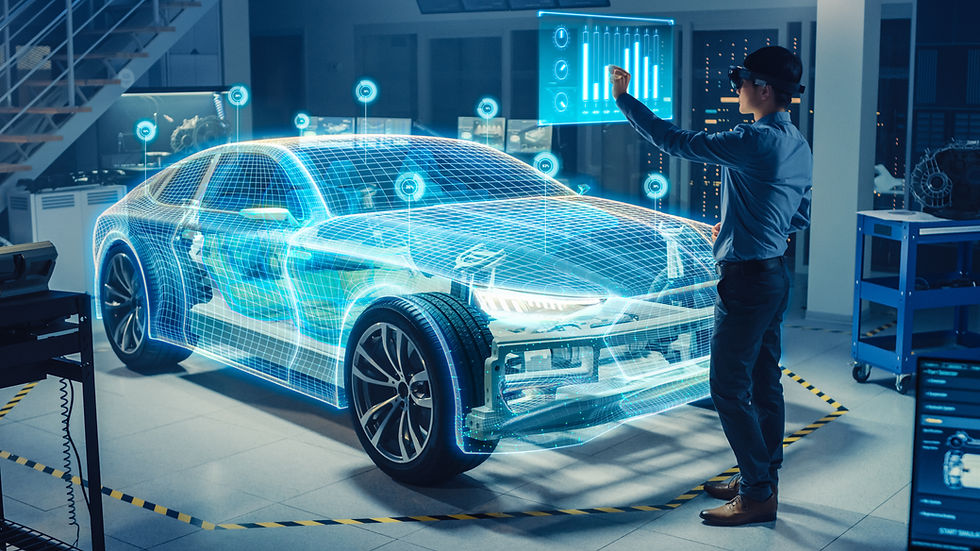Does my car need ADAS calibration?
- PW Auto Repairs

- Jun 18, 2024
- 4 min read
Updated: Feb 6
Our vehicles increasingly come equipped with new, sophisticated solutions to assist us and keep us safer. Using rapid technology advances, our vehicles are becoming intelligent and reactive - helping to prevent human errors, make driving safer and more comfortable. However, these complex safety solutions require precision and accuracy to prevent them becoming part of the problem!

The lines of virtual reality are starting to blur with data-driven vehicles
What is ADAS?
ADAS stands for Advanced Driver Assistance Systems. This is a collective term for features such as Front Collision Warning, Autonomous Emergency Braking, Adaptive Cruise Control, Park Assist, Lane Assist etc - and as technology moves forward, more safety systems will be added to our vehicles every year.
In recent years, ADAS equipment has increased rapidly, however we have seen various forms of it for quite a while, from anti-lock braking to adaptive cruise control. Vehicle Manufacturers and innovators in the Automotive Industry have found ways of using it to improve safety for all road users. Crucially, for it to work properly it has to be maintained, aligned and calibrated at all times.
There are two forms of ADAS calibration - static and dynamic. Static ADAS calibration is when the car is in a fixed position and dynamic ADAS calibration requires the vehicle to be in driven during the process.

What type of ADAS features are on vehicles?
Adaptive Cruise Control (ACC) is designed to automatically adjust the vehicle’s speed to maintain a safe distance from the vehicle in front. It can accelerate or decelerate the car without driver intervention whilst observing speed limits.
Parking Assistance includes features such as parking sensors and automated parking systems which help the driver park the vehicle with ease and precision.
Autonomous Emergency Braking (AEB) starts breaking automatically if the driver is not responding fast enough.
Lane Departure Warning (LDW) visually monitors lane markings and alerts the driver if the vehicle drifts out of its lane.
Lane Keeping Assist (LKA) can actively steer the car to keep it within the centre of the lane.
Pedestrian Detection identifies and alerts the driver to pedestrians who are in, or close to, the vehicle’s path.
Blind Spot Detection (BSD) monitors blind spots and alerts the driver if there is a vehicle in the adjacent lane.
Forward Collision Warning (FCW) warns the driver they are getting dangerously close to a vehicle in front.
Traffic Sign Recognition (TSR) uses cameras to recognise road signs such as speed limits, stop signs and alerts the driver to them.
Driver Monitoring Systems (DMS) uses cameras and sensors to monitor the driver’s behavior and attentiveness - and issues warnings if signs of distraction or fatigue are detected.
Rear-View Cameras give the user a clear view of the area behind the vehicle when reversing, helping to prevent collisions and making parking easier.
Night Vision uses technology to enhance the driver's visibility at night by detecting objects, animals, or pedestrians on the road.
Adaptive Headlights alter the intensity and direction of lights to help illuminate the roadway at night or in bad weather, based on speed, steering and road conditions. (Note - It does not automatically switch between high and low beam).

Why does the ADAS on my car need to be calibrated?
ADAS calibration is required when repairing, removing, refitting, aligning or making any changes to the vehicle's geometry, ride height or suspension, and replacing or refitting any ADAS sensors or associated vehicle parts. ADAS calibration is required following many repairs involving wheel alignment and replacements of items such as the windscreen.
ADAS relies on windscreen-mounted equipment. When it comes to damaged windscreens, you should opt for a genuine replacement if possible, or an OEM (Original Equipment Manufacturer) windscreen to ensure it is the same specification as the vehicle was manufactured to - ADAS calibration following windscreen replacement is vital.
We always recommend that you refer to the advice of the vehicle manufacturer regarding ADAS calibration prior to repairs and alignment if you drive a vehicle that features ADAS technology.
Accurate Data:
Radars, sensors and cameras are used to monitor the vehicle's surroundings. Following repairs, if these components are misaligned it can lead to incorrect data interpretation, causing inaccuracy and lack of effectiveness.
Reliability:
ADAS features are designed to enhance vehicle safety. Calibration ensures these systems function correctly. Not calibrating ADAS creates inaccuracy and increases the risk of accidents due to the data being incorrect. If calibration is not carried out, the system may no trigger, or trigger unexpectedly, resulting in a dangerous situation. A pedestrian detection system needs to be able to determine whether a pedestrian has stepped into the road. If the system makes the wrong choice due to inaccurate data, it could result in a collision.
Manufacturer Specification:
ADAS is designed with precise specifications by the manufacturer. Correct calibration ensures that the repaired vehicle meets these specifications as per the way the system was originally designed.
Malfunctions and False Alarms :
Uncalibrated systems can cause a failure to alert the driver to critical situation in which they would have relied on or assumed would react. It can also cause false alarms and unnecessary warnings or activations.
Insurance and Liability:
Failure to calibrate, or no proof of calibration being carried out, may affect insurance claims and affect liability in the event of an incident.
Optimal Driving Experience:
Correctly calibrated ADAS improves the driving experience by providing reliable systems working in synchronisation, leading to an all round better driving experience.
Resale Value of the Vehicle:
Evidence of ADAS calibration can help preserve a vehicle’s resale value.










Comments